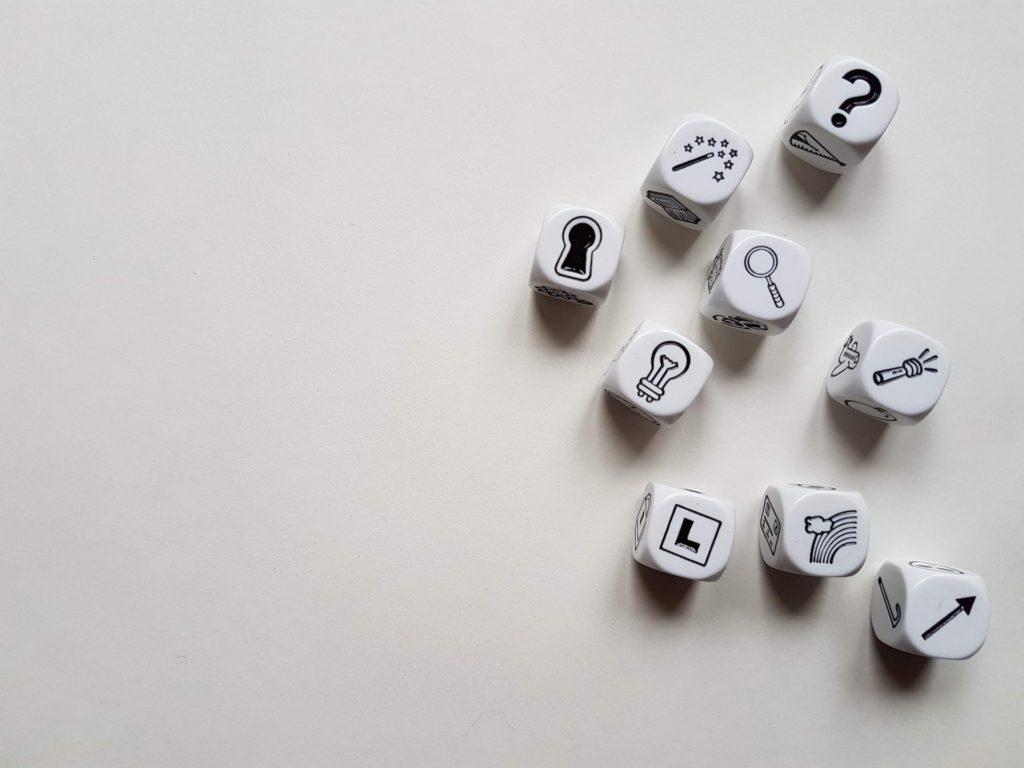August 23, 2021
Are Story Dice Worth It? Yes, With an Important Caveat
Story dice are dice (either physical or digital) that have not numbers but icons. Options vary, but usually they are objects, characters, abstract ideas, and other such depictions. How do you use story dice as a writer? Simple: You roll them, then you try to come up with a story containing the icons you see.
Obviously, it’s your creativity and imagination that do virtually all of the work. Though story dice are essentially writing prompts, they can’t provide you with an actual story (duh!)
So, here’s the question of the post title: Are story dice worth it for a writer? The answer is (again, echoing the title) yes, story dice are worth it – but with an important caveat.
If you’re perceptive enough, you’ve surely realized what that is: You! Since story dice depend on the user’s creativity to “function”, they are as good or bad as the person rolling them. Still, it’s not quite as black-and-white. To put it another way, you can learn to use them better.
And so, in this post we’ll take a look at story dice and how to use them as a writer, to get intriguing new ideas for your stories. I’ll also have a little surprise for you at the end of this post!

How Story Dice Work
This is very simple, really, but before we talk about how to use story dice, we should really make sure we all understand what we’re talking about.
Story (or storytelling) dice come in many shapes and forms. As I said, they can be found in physical or digital form. In most cases, you get to roll three or four dice at a time. Some sets might be more complex, but I think less is more. After all, the less you have to work with, the more creative you become.
Here’s a graspable example of what a set of digital storytelling dice might return:

An image of a pool, an image of a camera, and an image depicting an ancient column. Now, how do we make a story out of this?
Remember: It’s All About You!
For people with little to no imagination, the answer is: “We don’t”.
But for a writer – and writing is a connection game – it’s all about creating something that isn’t thereWe could get into metaphysics and wonder whether it is "somewhere", in abstract form, waiting to be thought of, but such a discussion would be outside the immediate scope of the post.. And so, armed with the above image and our authorial creativity, we could come up with something like this:
A man finds a camera forgotten at a swimming pool. The memory card contains perfect images of the mythical city of Atlantis.
Or, how about this:
After almost drowning, Joe decides to turn his life around and travel the world, taking pictures and visiting old monuments. But a chance encounter in Rome will force him to face his past.
How about another example?

What happens when you combine a nun with a divine voice and a death metal record company? Answer: money and trouble.
The trick in using story dice skillfully lies in understanding two important things:
- As I already explained, you are the driving force behind creating a story. The dice only help you come up with ideas.
- This is even more important: What this entire process reveals is that plots are secondary.
Great stories are not about coming up with “the perfect plot”, because there is no such thing. In a way, a plot is a necessary evil; a vehicle that you need to express affect. A good plot is one that doesn’t get in the way. That’s about it.
“How Can I Use Story Dice Efficiently?”
Let’s expand a bit on the advice above. To make it practical, I’ll offer my tips in a list form. Think of them as steps.
- Be in the right mood. This might sound ridiculously evident, but to be creative we need to be in the “right” mood. Only you can define that – for some it means to be happy and relaxed, for others to be in anguish. Whatever works for you.
- Roll the dice with no expectations. Don’t rely on the dice for solutions; they only offer hints. Realize that it’s you who’s doing all the work, and the dice only help you find the loose ends in your mind.
- Great stories come not from plot. As I said above, it’s not the plot itself that matters but the way it can allow you to throw characters into peculiar situations. Don’t be too preoccupied with coming up with a story that is “larger than life”. Not only is that impossible with storytelling dice, it’s also a bad idea in general.
- Don’t be preoccupied with genre. You might be a genre writer, a literary fiction writer, or something in between. It doesn’t matter. Just focus on coming up with an odd, charged setup, like the ones I described above. In some sense, think that the dice help you come up with the beginning of a novel or an elevator pitch.
Where Can You Find Some Good Story Dice?
Here’s the surprise I promised you! The example images above are actually from an app I’ve made, unoriginally called “Story Dice”. It’s remarkably simple – which is what you’d expect from such a program. You press a button, it shows you images (from a pool containing hundreds of icons, yielding over 150,000,000 possible combinations), and then your mind does the rest. If you like a particular image, you also have the option to save it on your computer.
You can try Story Dice following this link. For a full list of my available programs, see the relevant page on the main site.
I don't show you ads or newsletter pop-ups; everything is offered for free. Wanna help support a human internet?
